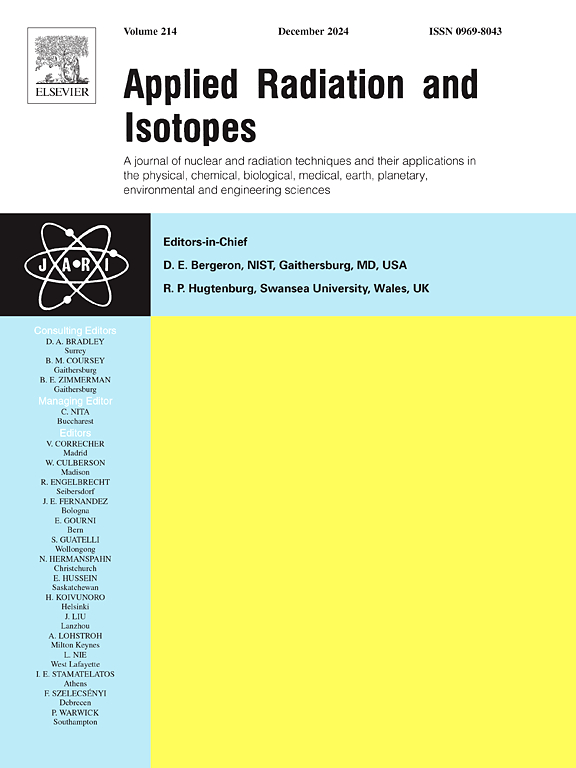Fast nuclide identification method based on hybrid dynamic Bayesian network
IF 1.8
3区 工程技术
Q3 CHEMISTRY, INORGANIC & NUCLEAR
引用次数: 0
Abstract
An efficient and precise nuclide identification method is essential in various contexts. This paper treats the detector output pulse events as a sequence of energy event models corresponding to monoenergetic rays and employs hybrid dynamic Bayesian network modeling, grounded in the energy spectrum response of the detector. The results from Monte Carlo simulations are utilized to assess the belief that each pulse event corresponds to different monoenergetic ray energy events. Furthermore, this paper introduces a probabilistic propagation algorithm that updates the prior probability of the particle transport model and continuously refines the parameters of the Bayesian network model according to the information of each pulse event, thereby enhancing the alignment with radiation detection scenarios. Building upon this foundation, the study employs a sequential test method to further enhance the speed and accuracy of nuclide identification. During implementation, this study constructs a noise model based on authentic background measurement data, simulating radiation detection scenarios for single-nuclide, dual-nuclide, and multi-nuclide cases. The results demonstrate that in single-nuclide scenarios, when the relative intensity ratio between background noise and nuclide radiation reaches 1:7, the identification accuracy exceeds 91.3 %. Under conditions where the relative intensity ratio of background, 60Co, and 137Cs is 10:10:1, the detection rate for 137Cs surpasses 81 %, while the detection rate for 60Co remains approximately at 100 %. When the relative intensity ratio of background, 133Ba, 60Co, 137Cs and 22Na is set to 8:1:1:1:1, the respective identification rates for 133Ba, 60Co, 137Cs, and 22Na reach 99.6 %, 99.1 %, 84.4 %, and 81.3 %, with the false alarm rate for non-target nuclides staying below 0.8 %. These findings validate the feasibility of the proposed method and highlight its significant potential in rapid nuclide identification.
基于混合动态贝叶斯网络的核素快速识别方法
一种高效、精确的核素识别方法在各种情况下都是必不可少的。本文将探测器输出脉冲事件视为一系列对应于单能射线的能量事件模型,并以探测器的能谱响应为基础,采用混合动态贝叶斯网络建模。利用蒙特卡罗模拟的结果来评估每个脉冲事件对应于不同的单能射线能量事件的信念。此外,本文引入了概率传播算法,该算法更新粒子输运模型的先验概率,并根据每个脉冲事件的信息不断细化贝叶斯网络模型的参数,从而增强了与辐射探测场景的一致性。在此基础上,本研究采用序贯试验方法,进一步提高核素鉴定的速度和准确性。在实施过程中,本研究基于真实背景测量数据构建噪声模型,模拟单核素、双核素和多核素辐射检测场景。结果表明,在单核素场景下,当背景噪声与核素辐射的相对强度比达到1:7时,识别准确率超过91.3%。在背景、60Co和137Cs的相对强度比为10:10:1的条件下,137Cs的检出率超过81%,而60Co的检出率保持在100%左右。当背景、133Ba、60Co、137Cs和22Na的相对强度比设置为8:1:1:1:1时,133Ba、60Co、137Cs和22Na的识别率分别达到99.6%、99.1%、84.4%和81.3%,对非靶核素的虚警率保持在0.8%以下。这些发现验证了所提出方法的可行性,并突出了其在快速核素鉴定方面的重大潜力。
本文章由计算机程序翻译,如有差异,请以英文原文为准。
求助全文
约1分钟内获得全文
求助全文
来源期刊

Applied Radiation and Isotopes
工程技术-核科学技术
CiteScore
3.00
自引率
12.50%
发文量
406
审稿时长
13.5 months
期刊介绍:
Applied Radiation and Isotopes provides a high quality medium for the publication of substantial, original and scientific and technological papers on the development and peaceful application of nuclear, radiation and radionuclide techniques in chemistry, physics, biochemistry, biology, medicine, security, engineering and in the earth, planetary and environmental sciences, all including dosimetry. Nuclear techniques are defined in the broadest sense and both experimental and theoretical papers are welcome. They include the development and use of α- and β-particles, X-rays and γ-rays, neutrons and other nuclear particles and radiations from all sources, including radionuclides, synchrotron sources, cyclotrons and reactors and from the natural environment.
The journal aims to publish papers with significance to an international audience, containing substantial novelty and scientific impact. The Editors reserve the rights to reject, with or without external review, papers that do not meet these criteria.
Papers dealing with radiation processing, i.e., where radiation is used to bring about a biological, chemical or physical change in a material, should be directed to our sister journal Radiation Physics and Chemistry.
 求助内容:
求助内容: 应助结果提醒方式:
应助结果提醒方式:


